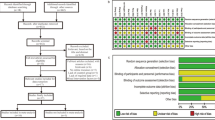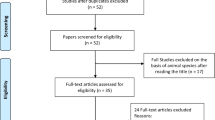Abstract
Pharmacological dietary zinc (Zn) concentrations of 1,000 to 3,000 mg/kg diet from Zn oxide have been found to increase growth in post-weaning pigs. However, results were inconsistent among studies. A frequentist meta-analysis, in which effects were numerically described with standardized effect sizes (Hedges's g), was conducted in order to identify and quantify the responses in average daily gain (ADG), average daily feed intake (ADFI), and gain to feed ratio (G/F) in post-weaning pigs upon dietary Zn supplementation from Zn oxide. The inability of independent continuous variables to explain significant heterogeneity obtained with fixed effect models necessitated the use of random effects models to calculate summary statistics. Dietary Zn supplementation increased (P < 0.05) ADG (mean effect size = 1.086, 95 % confidence intervals = 0.905–1.266, 26 studies, 72 comparisons), ADFI (mean effect size = 0.794, 95 % confidence intervals = 0.616–0.971, 25 studies, 71 comparisons), and G/F (mean effect size = 0.566, 95 % confidence intervals = 0.422–0.710, 24 studies, 70 comparisons). Zinc oxide provided a feasible alternative to in-feed antibiotics to improve growth in post-weaning pigs, and its reduction in diets due to potential environmental pollution will have to be negated by alternative feed additives and management strategies in order to prevent economic losses.
Similar content being viewed by others
References
National Research Council (NRC) (1998) Nutrient requirements of swine, 10th edn. National Academic, Washington
Poulsen HD (1989) Zinc oxide for weaned pigs. In: Proceedings of the 40th annual meeting of the European Association for Animal Production. EAAP Publications, Dublin, pp 265–266
Brink MF, Becker DE, Terrill SW, Jensen AH (1959) Zinc toxicity in the weanling pig. J Anim Sci 18:836–842
Grimmett RER, McIntosh IG, Wall EM, Hopkirk CSM (1937) Chromium zinc poisoning of pigs. Results of experimental feeding of pure zinc lactate. NZ J Agric 54:216–223
Hahn JD, Baker DH (1993) Growth and plasma zinc responses of young pigs fed pharmacologic levels of zinc. J Anim Sci 71:3020–3024
Anonymous (2003) Commission Regulation (EC) no. 1334/2003 of 25 July 2003 amending the conditions for authorisation of a number of additives in feedingstuffs belonging to the group of trace elements. Off J Eur Union L187:11–15
European Commission (2003) Opinion of the scientific committee for animal nutrition on the use of zinc in feedingstuffs. European Commission, Health and Consumer Protection Directorate, Brussels
Case CL, Carlson MS (2002) Effect of feeding organic and inorganic sources of additional zinc on growth performance and zinc balance in nursery pigs. J Anim Sci 80:1917–1924
Shelton NW, Tokach MD, Nelssen JL, Goodband RD, Dritz SS, DeRouchey JM, Hill GM (2011) Effects of copper sulfate, tri-basic copper chloride, and zinc oxide on weanling pig performance. J Anim Sci 89:2440–2451
Heo JM, Kim JC, Hansen CF, Mullan BP, Hampson DJ, Pluske JR (2010) Effects of dietary protein level and zinc oxide supplementation on performance responses and gastrointestinal tract characteristics in weaner pigs challenged with an enterotoxigenic strain of Escherichia coli. Anim Prod Sci 50:827–836
Owusu-Asiedu A, Nyachoti CM, Marquardt RR (2003) Response of early-weaned pigs to an enterotoxigenic Escherichia coli (K88) challenge when fed diets containing spray-dried porcine plasma or pea protein isolate plus egg yolk antibody, zinc oxide, fumaric acid, or antibiotic. J Anim Sci 81:1790–1798
Wang YZ, Xu ZR, Lin WX, Huang HQ, Wang ZQ (2004) Developmental gene expression of antimicrobial peptide PR-39 and effect of zinc oxide on gene regulation of PR-39 in piglets. Asian-Australas J Anim Sci 17:1635–1640
Buff CE, Bollinger DW, Ellersieck MR, Brommelsiek WA, Veum TL (2005) Comparison of growth performance and zinc absorption, retention, and excretion in weanling pigs fed diets supplemented with zinc-polysaccharide or zinc oxide. J Anim Sci 83:2380–2386
Carlson MS, Boren CA, Wu C, Huntington CE, Bollinger DW, Veum TL (2004) Evaluation of various inclusion rates of organic zinc either as polysaccharide or proteinate complex on the growth performance, plasma, and excretion of nursery pigs. J Anim Sci 82:1359–1366
Hill GM, Cromwell GL, Crenshaw TD, Dove CR, Ewan RC, Knabe DA, Lewis AJ, Libal GW, Mahan DC, Shurson GC, Southern LL, Veum TL (2000) Growth promotion effects and plasma changes from feeding high dietary concentrations of zinc and copper to weanling pigs (regional study). J Anim Sci 78:1010–1016
Hill GM, Mahan DC, Carter SD, Cromwell GL, Ewan RC, Harrold RL, Lewis AJ, Miller PS, Shurson GC, Veum TL (2001) Effect of pharmacological concentrations of zinc oxide with or without the inclusion of an antibacterial agent on nursery pig performance. J Anim Sci 79:934–941
Hollis GR, Carter SD, Cline TR, Crenshaw TD, Cromwell GL, Hill GM, Kim SW, Lewis AJ, Mahan DC, Miller PS, Stein HH, Veum TL (2005) Effects of replacing pharmacological levels of dietary zinc oxide with lower dietary levels of various organic zinc sources for weanling pigs. J Anim Sci 83:2123–2129
LeMieux FM, Southern LL, Bidner TD (2003) Effect of mannan oligosaccharides on growth performance of weanling pigs. J Anim Sci 81:2482–2487
Ragland D, Schneider JL, Amass SF, Hill MA (2006) Alternatives to the use of antimicrobial feed additives in nursery diets: a pilot study. J Swine Health Prod 14:82–88
Smith JW II, Tokach MD, Goodband RD, Nelssen JL, Richert B (1997) Effects of the interrelationship between zinc oxide and copper sulfate on growth performance of early-weaned pigs. J Anim Sci 75:1861–1866
Williams SB, Southern LL, Bidner TD (2005) Effects of supplemental dietary phytase and pharmacological concentrations of zinc on growth performance and tissue zinc concentrations of weanling pigs. J Anim Sci 83:386–392
Wilt HD, Carlson MS (2009) Effect of supplementing zinc oxide and biotin with or without carbadox on nursery pig performance. J Anim Sci 87:3253–3258
Woodworth JC, Tokach MD, Nelssen JL, Goodband RD, Quinn PRO, Fakler TM (2005) Interactive effects of diet complexity, zinc source, and feed-grade antibiotics on weanling pig growth performance. J Anim Vet Adv 4:688–693
Yin J, Li X, Li XD, Yue T, Fang Q, Ni J, Zhou X, Wu G (2009) Dietary supplementation with zinc oxide stimulates ghrelin secretion from the stomach of young pigs. J Nutr Biochem 20:783–790
Han Y-K, Thacker PA (2010) Effects of antibiotics, zinc oxide or a rare earth mineral-yeast product on performance, nutrient digestibility and serum parameters in weanling pigs. Asian-Australas J Anim Sci 23:1057–1065
Han Y-K, Thacker PA (2010) Performance, nutrient digestibility and nutrient balance in weaned pigs fed diets supplemented with antibiotics or zinc oxide. J Anim Vet Adv 8:868–875
Pérez VG, Waguespack AM, Bidner TD, Southern LL, Fakler TM, Ward TL, Steidinger M, Pettigrew JE (2011) Additivity of effects from dietary copper and zinc on growth performance and fecal microbiota of pigs after weaning. J Anim Sci 89:414–425
Carlson MS, Hill GM, Link JE (1999) Early- and traditionally weaned nursery pigs benefit from phase-feeding pharmacological concentrations of zinc oxide: effect on metallothionein and mineral concentrations. J Anim Sci 77:1199–1207
Li X, Yin J, Li D, Chen X, Zang J, Zhou X (2006) Dietary supplementation with zinc oxide increases IGF-I and IGF-I receptor gene expression in the small intestine of weanling piglets. J Nutr 136:1786–1791
Sales J (2011) A meta-analysis of the effects of dietary betaine supplementation on finishing performance and carcass characteristics of pigs. Anim Feed Sci Technol 165:68–78
Sales J, Glencross B (2011) A meta-analysis of the effects of dietary marine oil replacement with vegetable oils on growth, feed conversion and muscle fatty acid composition of fish species. Aquac Nutr 17:e271–e287
Sales J, Homolka P (2011) A meta-analysis of the effects of supplemental dietary fat on protein and fibre digestibility in the horse. Livest Sci 136:55–63
Steidl RJ, Thomas (2001) Power analysis and experimental design. In: Scheiner SM, Gurevitch J (eds) Design and analysis of ecological experiments. Oxford University Press, New York, pp 14–36
Cohen J (1988) Statistical power analysis for the behavioral sciences, 2nd edn. Lawrence Erlbaum Associates, Hillsdale
Sales J, Jančík F (2011) Effects of dietary chromium supplementation on performance, carcass characteristics and meat quality of growing-finishing swine: a meta-analysis. J Anim Sci 89:4054–4067
Hedges LV, Olkin I (1985) Statistical methods for meta-analysis. Academic, San Diego
DerSimonian R, Laird N (1986) Meta-analysis in clinical trials. Control Clin Trials 7:177–188
Borenstein M, Hedges LV, Higgins JPT, Rothstein HR (2009) Introduction to meta-analysis. Wiley, Chichester
Borenstein M, Hedges LV, Higgins JPT, Rothstein HR (2005) Comprehensive meta-analysis version 2. Biostat, Engelwood
Lipsey MW, Wilson DB (2000) Practical meta-analysis, 3rd edn. Sage Publications Inc., Thousand Oaks
Ioannidis JPA, Trikalinos TA (2007) The appropriateness of asymmetry tests for publication bias in meta-analyses: a large survey. Can Med Assoc J 176:1091–1096
Højberg O, Canibe N, Poulsen HD, Hedemann MS, Jensen BB (2005) Influence of dietary zinc oxide and copper sulfate on the gastrointestinal ecosystem in newly weaned piglets. Appl Environ Microbiol 71:2267–2277
Vahjen W, Pieper R, Zentek J (2011) Increased dietary zinc oxide changes the bacterial core and enterobacterial composition in the ileum of piglets. J Anim Sci 89:2430–2439
Pieper R, Vahjen W, Neumann K, Van Kessel AG, Zentek J (2012) Dose-dependent effects of dietary zinc oxide on bacterial communities and metabolic profiles in the ileum of weaned pigs. J Anim Physiol Anim Nutr 96:825–833
Zhang BK, Guo YM (2007) Beneficial effects of tetrabasic zinc chloride for weanling piglets and the bioavailability of zinc in tetrabasic form relative to ZnO. Anim Feed Sci Technol 135:75–85
Mavromichalis I, Peter CM, Parr TM, Ganessunker D, Baker DH (2000) Growth-promoting efficacy in young pigs of two sources of zinc oxide having either a high or a low bioavailability of zinc. J Anim Sci 78:2896–2902
Windisch W, Schwarz FJ, Gruber K, Kirchgessner M (1998) Effect of pharmacological dietary doses of zinc oxide on performance and fecal characteristics of weanling piglets. Agribiol Res 51:277–285
Rincker MJ, Hill GM, Link JE, Meyer AM, Rowntree JE (2005) Effects of dietary zinc and iron supplementation on mineral excretion, body composition, and mineral status of nursery pigs. J Anim Sci 83:2762–2774
Jondreville C, Revy PS, Dourmad JY (2003) Dietary means to better control the environmental impact of copper and zinc by pigs from weaning to slaughter. Livest Prod Sci 84:147–156
Roselli M, Finamore A, Britti MS, Bosi P, Oswald I, Mengheri E (2005) Alternatives to in-feed antibiotics in pigs: evaluation of probiotics, zinc or organic acids as protective agents for the intestinal mucosa. A comparison of in vitro and in vivo results. Anim Res 54:203–218
Broom LJ, Miller HM, Kerr KG, Toplis P (2003) Removal of both zinc oxide and avilamycin from the post-weaning piglet diet: consequences for performance through to slaughter. Anim Sci 77:79–84
Augspurger NR, Spencer JD, Webel DM, Baker DH (2004) Pharmacological zinc levels reduce the phosphorus-releasing efficacy of phytase in young pigs and chickens. J Anim Sci 82:1732–1739
Mavromichalis I, Webel DM, Parr EN, Baker DH (2001) Growth-promoting efficacy of pharmacological doses of tetrabasic zinc chloride in diets for nursery pigs. Can J Anim Sci 81:387–391
Schell TC, Kornegay ET (1996) Zinc concentration in tissues and performance of weanling pigs fed pharmacological levels of zinc from ZnO, Zn-methionine, Zn-lysine, or ZnSO4. J Anim Sci 74:1584–1593
Acknowledgments
The project was supported by the Ministry of Agriculture of the Czech Republic (Prague, Czech Republic, MZE0002701404).
Author information
Authors and Affiliations
Corresponding author
Rights and permissions
About this article
Cite this article
Sales, J. Effects of Pharmacological Concentrations of Dietary Zinc Oxide on Growth of Post-weaning Pigs: A Meta-analysis. Biol Trace Elem Res 152, 343–349 (2013). https://doi.org/10.1007/s12011-013-9638-3
Received:
Accepted:
Published:
Issue Date:
DOI: https://doi.org/10.1007/s12011-013-9638-3




